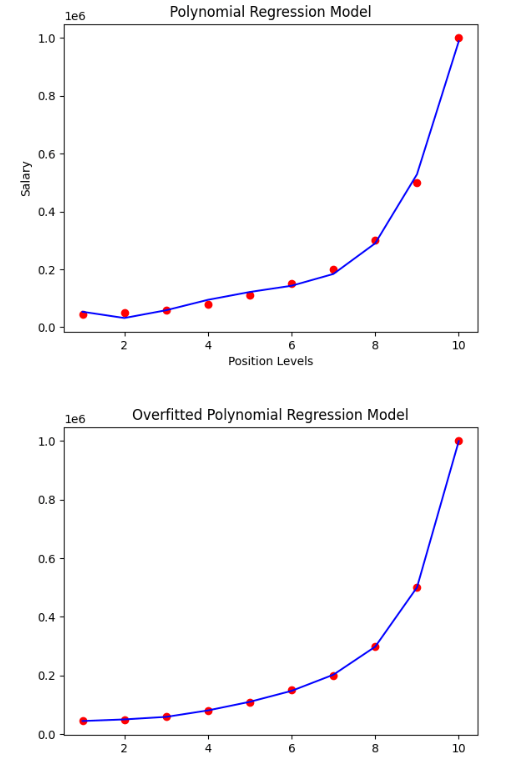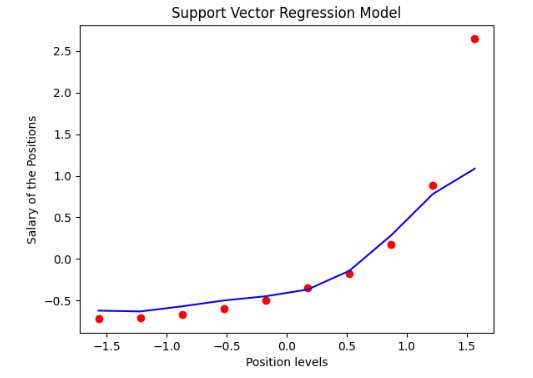Sklearn Regression ModelsMachine learning is utilized to tackle the regression question using two different algorithms to perform regression analysis: logistic regression and linear regression. These are the most widely used regression approaches. Regression analysis approaches in machine learning come in many algorithms, and their use depends on the type of data and the analysis aim. This tutorial will describe the various machine learning regression models and the circumstances in which we can apply each. This tutorial will undoubtedly aid us in grasping the regression modelling concept if one is a novice to machine learning. Regression ModelsIn the supervised machine learning paradigm, the system is taught the results. The model's input and output variables are known to us, and both are used for training the algorithm. The algorithm is fed the true values in the training phase, and the machine learning model is trained to lower the prediction error. The two main supervised learning algorithm categories are regression (for the continuous target variable) and classification (for the discrete target variable). A predictive modelling method called regression analysis examines the relationship between the target or dependent feature and the independent feature of a dataset. Various regression models are used depending on if the dependent and independent features exhibit a linear or a non-linear association between one another or if the target feature has continuous values. Regression analysis is frequently used to identify cause and effect relationships, forecast trends, time series forecasting analysis, and predictor strength. Regression gives the result as continuous data. With the help of this technique, which is centered on characteristics, we may predict the patterns of the training data. The output is a real numerical number; however, it doesn't fall into any class or category. For instance, estimating property values depends on details like a home's size, locality, and development ratio, among many other things. Types of Regression Analysis TechniquesRegression analysis approaches come in a wide variety, and factors, as discussed above, will determine which technique is used. Examples of these factors are the regression line pattern and the number of independent features. The many regression approaches are listed below:
Linear RegressionA machine learning method called linear regression establishes a linear relationship among one or multiple independent features and a particular dependent feature to forecast the dependent feature's best value by predicting the linear equation's variables' coefficients. The simple linear regression model calculates the best fitting line for a dependent feature (y) and a single independent feature (x). The accompanying straight-line equation defines it. m is the regression coefficient. It indicates how much we anticipate y to alter as the value of x changes. The regression model determines the optimal intercept (c) value and regression coefficients to minimize the error (e). The algorithm finds the optimum values of the parameters by reducing the error between the actual values of target variable y and the values predicted by the model. The ordinary least squares approach is used to calculate the error. It can accommodate many input variables present in the dataset. Code Output: [151. 75. 141. 206. 135. 97. 138. 63. 110. 310.] The r-square score of the Simple Linear Regression model: 0.3195508704110651 Features Coefficients 0 Intercept 150.559849 1 sex -207.159699 2 bmi 545.523615 3 bp 282.960253 4 s1 -1195.950976 5 s2 580.404692 6 s3 404.413845 7 s4 431.717208 8 s5 871.098497 9 s6 118.346669 Logistic RegressionLogistic Regression is another type of regression modelling technique employed if the dependent feature is discrete, such as true or false, 0 or 1, etc. As a result, the dependent variable has only two possible values to take, and a sigmoid curve depicts the association between the target and input variables. The logistic regression algorithm uses the logit function to quantify the relationship between the target and input variables. Code Output: 1.0 Ridge RegressionWhen independent features have a high correlation value, the Ridge regression algorithm predicts the target variable. This is because, for non-collinear variables, the least square estimates an unbiased answer. However, there may be a bias component if the collinearity is strong. As a result, a bias grid is induced in the equation of Ridge Regression. This powerful regression method makes the constructed model much less likely to overfit. Code Output: Accuracy score for solver = "auto": 0.40731258229249656 Accuracy score for solver = "lsqr": 0.4073540170017558 Lasso RegressionOne regression model applied in learning algorithms that integrate feature selection, and normalization procedures are called Lasso Regression. The absolute value of the regression coefficient is not considered. As an outcome, unlike in Ridge Regression, the independent features' coefficient value is close to zero. Lasso Regression involves feature selection. This process permits selecting a group of variables from the given dataset, which will cause more change in the model than other variables. In Lasso Regression, all other features are set to zero except for the features required to make good predictions. This step helps keep the model from overfitting. When the collinearity value of the dataset's independent factors is severe, lasso regression only chooses one variable and reduces the coefficients of the other variables to zero. Code Output: The accuracy score of the model is: 0.40131502999775714 Polynomial RegressionAnother regression analysis method used in learning algorithms is polynomial regression. This method is similar to multiple linear regression with some minor adjustments. The nth degree in the polynomial regression defines the link between the independent and dependent features, X and Y. As a predictor, it uses a linear model for regression; we scale the features using a polynomial scaler function of sklearn. The algorithm of polynomial regression, like linear regression, uses the Ordinary Least Squares method to compare the errors of the lines. Instead of being a straight line in polynomial regression, the best-fitting line has a curve and depending on the power of X or the value of n, it crosses the data points. While trying to achieve the lowest value of the OLS equation and find the best-fitting curve, the polynomial regression model is prone to overfitting. Evaluating the different regression curves, in the end, is advised because extrapolating higher polynomials can produce odd results. The dataset is available here- https://github.com/content-anu/dataset-polynomial-regression Code Output: 
Bayesian Linear RegressionOne of the regression models used in machine learning, Bayesian Regression, calculates the magnitude of the regression coefficients using the Bayes theorem. Rather than locating the least squares, this regression approach determines the variables' posterior distribution. Like the linear regression and ridge regression methods, the Bayesian linear regression method is much more robust than simple linear regression. Code Output: The r2 score of the model is: 0.6312926702997255 Elastic Net RegressionElastic net regression is a regularised linear regression approach. It inserts the L1 and L2 costs to the loss function while training by linearly combining both. It blends lasso and ridge regression by giving each penalty the proper weight, enhancing predictive accuracy. Alpha and Lambda are the two configurable hyperparameters for elastic nets. Lambda controls the proportion of the weighted total of the two penalties that determines the model's effectiveness. In contrast, the alpha parameter controls the weight assigned to each penalty individually. Code Output: [0.66666667 1.79069767] 2.461240310077521 [12.29069767] [2.46124031] Decision Tree RegressionIt is possible to represent judgments and all of their probable consequences, covering outcomes, input penalties, and utility, using a decision-making tool called a decision tree. The supervised learning methods group includes the decision-tree strategy, and it functions with output results that are categorical and continuous values. Decision Tree Regression: Decision tree regression develops a model to forecast future data to provide relevant continuous output by observing the attributes of an item and providing these attributes as input to the algorithm. Continuous output denotes the absence of a discrete outcome, i.e., output that is not only expressed by a discrete, well-known collection of figures or values. Code Output: Accuracy scores of the splits: [-1.02298964 0.05276312 -0.74850198 -0.07277615 0.47050685 0.3024374 -1.31209035 -0.26358347 0.43173477 -0.19109809 -0.56778646 -0.61486148 -0.11295867 0.0408493 -0.26464188] The mean accuracy score of the model: -0.25819978131125926 Support Vector RegressionSupport Vector Regression (SVR) is unique compared to other regression models. It employs the Support Vector Machine (SVM, a classification approach) to forecast a continuous parameter. Support Vector Regression seeks to fit the best line inside a predetermined or threshold deviation value, as opposed to conventional linear regression models that aim to minimize the discrepancy between the estimated and actual value. In this respect, SVR categorizes all forecasting lines into two types: those that cross the error limit (a region divided by two parallel lines) and those that do not. When determining whether the discrepancy between the estimated value and the true value is beyond the error threshold, the lines that do not cross the error border are not considered (epsilon). The lines crossing the error threshold are added to the group of potential support vectors for forecasting an unknown value. We can better understand this idea if we look at the illustration below. The kernel parameter of SVR is the most crucial It could be a Gaussian kernel, a Polynomial kernel, or a Linear kernel. We can choose a Polynomial or Gaussian kernel for our model as we have a non-linear property in the dataset, but in this case, we will select an RBF (Gaussian type) kernel. Code Output: 
Gradient Boosting RegressionWe may apply a gradient boosting technique if there are difficulties with classification and regression methods. A predictive model is built using numerous smaller prediction models; these tiny models are often decision trees. A loss function is necessary for the Gradient Boosting Regressor to perform. Gradient boosting regressors can handle a variety of predefined loss functions in addition to supporting customized loss functions; however, the loss function has to be differentiable. Even though regression methods generally use the logarithmic function, squared errors can also be employed in regression techniques. We don't have to construct a loss function for each progressive boosting stage in gradient boosting algorithms; instead, we can choose whatever differentiable loss function. Code Output: Accuracy scores: [-1.02298964 0.05276312 -0.74850198 -0.07277615 0.47050685 0.3024374 -1.31209035 -0.26358347 0.43173477 -0.19109809 -0.56778646 -0.61486148 -0.11295867 0.0408493 -0.26464188] The mean accuracy score is: -0.25819978131125926 Regression Can Handle Linear DependenciesA reliable method for forecasting numerical variables is regression. The machine learning techniques above include effective regression methods that can use the sklearn Python library to perform regression analysis and forecasting for various machine learning tasks. But regression is a better option when a dataset has linear correlations between independent and dependent characteristics. Other regression algorithms, like neural networks, are employed to manage non-linear connections between data features because they can record non-linearity using activation functions. |
 For Videos Join Our Youtube Channel: Join Now
For Videos Join Our Youtube Channel: Join Now
Feedback
- Send your Feedback to [email protected]
Help Others, Please Share










